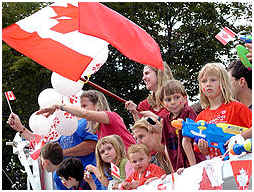|

Canada Day

From
Wikipedia, the free encyclopedia
http://en.wikipedia.org/wiki/Canada_Day

Canada Day (French: Fête du Canada), formerly Dominion Day (French: Le
Jour de la Confédération), is Canada's national day, a federal statutory
holiday celebrating the anniversary of the 1 July 1867 enactment of the British
North America Act, which united Canada as a single country, which was in turn
composed of four provinces. Canada Day observances take place throughout Canada
as well as internationally.
Frequently referred to as "Canada's birthday", particularly in
the popular press, the occasion marks the joining of the British North American
colonies of Nova Scotia, New Brunswick, and the Province of Canada into a
federation of four provinces (the Province of Canada being divided, in the
process, into Ontario and Quebec) on 1 July 1867. Although Canada is regarded as
having become a kingdom in its own right on that date, the British Parliament
kept limited rights of political control over the new country that were shed by
stages over the years until the last vestiges were surrendered in 1982 when the
Constitution Act patriated the Canadian constitution.
Exceptions
Under the federal Holidays Act, Canada Day is observed on 1 July unless
that date falls on a Sunday, in which case 2 July is the statutory holiday,
although celebratory events generally take place on 1 July even though it is not
the legal holiday. If it falls on a
Saturday, the following Monday is generally also a day off for those businesses
ordinarily closed on Saturdays.

Canada Day is an opportunity to gather in our communities, from coast to
coast to coast, and to proudly celebrate all we have in common. It is an
opportunity to celebrate our achievements, which were born in the audacious
vision and shared values of our ancestors, and which are voiced in nearly all of
the languages of the world through the contribution of new Canadians.
Did
you know?
That
the July 1 holiday was established by statute in 1879, under the name Dominion
Day.
Dominion
Day
Origin
and special observance
Proclamation
requiring celebration of July 1st:
On June 20, 1868 a proclamation issued by the Governor General, Lord
Monck, enjoined and called upon all Her Majesty's loving subjects throughout
Canada to join in the celebration of the Anniversary of the formation of the
Dominion of Canada on the 1st of July, 1868. This proclamation, a copy of which
is attached, was published in the Canada Gazette on Saturday, June 20, 1868.
Act
respecting Dominion Day, 1879:
On May 15, 1879, Royal Assent was given to "An Act to make the first
day of July a Public Holiday by the name of Dominion Day" (House of Commons
Debates, 1879, Vol.II, p. 2047).
Proclamation
respecting the celebration of the 50th Anniversary:
On June 16, 1917, the Governor General, the Duke of Devonshire, issued a
proclamation appointing Monday the 2nd Day of July 1917 for the special
celebration of the 50thAnniversary of Confederation.
Diamond
Jubilee of Confederation Act
1927-Incorporation
of the National Committee:
On
February 18, 1927, Royal Assent was given to an act to incorporate a National
Committee for the celebration of the Diamond Jubilee of Confederation - 17
George V, Chap. 6. This Act is entitled the Diamond Jubilee of Confederation
Act, 1927.
The Committee, called the Corporation comprised about seventy persons
including the Governor General and his wife, the lieutenant governors of the
provinces, the Prime Minister of Canada and seven members of the Cabinet (but
not the Secretary of State), the Chief Justice, several privy councillors
including the former prime minister, the speakers of both Houses, the Leader of
the Opposition, the premiers of all the provinces, several senators and the
Leader of the Opposition in the Senate, the Clerk of the Privy Council, the
Under Secretary of State, the Dominion Archivist, the Under Secretary of State
for External Affairs and the heads of a number of organizations such as the
National Council of Women, the Trades and Labour Congress, the United Farmers of
Alberta, I.O.D.E., Bar Association, the National Battlefields Commission, the
Canadian Legion, etc.
The objects of the Corporation were to make and carry out necessary
arrangements in cooperation with the provinces and other bodies for an effective
celebration of the sixtieth anniversary of the formation of the Dominion of
Canada, and to administer and distribute a grant of $250,000. The affairs of the
corporation were administered by an executive committee; the Secretary of State
of Canada convened the first meeting of this committee.
1927
Celebration across Canada:
The National Committee issued a booklet entitled "Order of
Proceedings" for national thanksgiving by the people of Canada for Sunday,
July 3, as a suggestion for local committees across Canada for a public
religious ceremony at 2:30 p.m. in each local time zone under the direction of
the lieutenant-governor or mayor or other senior person in the community. The
Prime Minister, the Right Honourable William Lyon Mackenzie King, who was a
Presbyterian, had edited this booklet; it was found to be not acceptable for
Roman Catholic usage.
The Committee issued a forty-eight page pamphlet, illustrated in colour,
containing suggestions for historical pageants, floats and tableaux for the
guidance bibliography of Canadian history.
1927
Ottawa Confederation:
The National Committee organized the program of national celebration at
Ottawa which began at 11:00 a.m. on Friday July 1, 1927 with the laying of the
cornerstone by the Governor General of the Confederation Building at the corner
of Bank and Wellington Streets, and continued with the inauguration of the
Carillon in the Peace Tower, the planting of the Confederation maple trees on
Parliament Hill and, in the afternoon, addresses by the Governor General, the
Prime Minister and the Leader of the Opposition and descendants of fathers of
Confederation interspersed with public singing lead by a centenary choir and
schoolchildren. There was a very large dinner given by the National Committee in
the Parliament buildings in the evening of July 1 preceded by a historical
pageant parade.

|